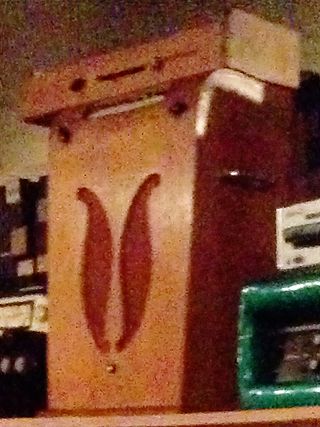
An electronic musical instrument or electrophone is a musical instrument that produces sound using electronic circuitry. Such an instrument sounds by outputting an electrical, electronic or digital audio signal that ultimately is plugged into a power amplifier which drives a loudspeaker, creating the sound heard by the performer and listener.

Lev Sergeyevich Termen, better known as Leon Theremin, was a Russian inventor, most famous for his invention of the theremin, one of the first electronic musical instruments and the first to be mass-produced. He also worked on early television research. His secret listening device, "The Thing", hung for seven years in plain view in the United States Ambassador's Moscow office and enabled Soviet agents to eavesdrop on secret conversations.

The theremin is an electronic musical instrument controlled without physical contact by the performer. It is named after its inventor, Leon Theremin, who patented the device in 1928.

An analogsynthesizer is a synthesizer that uses analog circuits and analog signals to generate sound electronically.

The Trautonium is an electronic synthesizer invented in 1930 by Friedrich Trautwein in Berlin at the Musikhochschule's music and radio lab, the Rundfunkversuchstelle. Soon afterwards Oskar Sala joined him, continuing development until Sala's death in 2002.

A MIDI controller is any hardware or software that generates and transmits Musical Instrument Digital Interface (MIDI) data to MIDI-enabled devices, typically to trigger sounds and control parameters of an electronic music performance. They most often use a musical keyboard to send data about the pitch of notes to play, although a MIDI controller may trigger lighting and other effects. A wind controller has a sensor that converts breath pressure to volume information and lip pressure to control pitch. Controllers for percussion and stringed instruments exist, as well as specialized and experimental devices. Some MIDI controllers are used in association with specific digital audio workstation software. The original MIDI specification has been extended to include a greater range of control features.

The Novachord is an electronic musical instrument often considered the world's first commercial polyphonic synthesizer. Incorporating many circuit and control elements found in modern synthesizers, and using subtractive synthesis to generate tones, it was designed by John M. Hanert, Laurens Hammond and C. N. Williams, and was manufactured by the Hammond company. Only 1,069 Novachords were built over a period from 1939 to 1942. It was one of very few electronic products released by Hammond that was not intended to emulate the sound of an organ.

The Continuum Fingerboard or Haken Continuum is a music performance controller and synthesizer developed by Lippold Haken, a professor of Electrical and Computer Engineering at the University of Illinois, and sold by Haken Audio, located in Champaign, Illinois.

A ribbon controller is a tactile sensor used to control synthesizers. It generally consists of a resistive strip that acts as a potentiometer. Because of its continuous control, ribbon controllers are often used to produce glissando effects.
Polyphony is a property of musical instruments that means that they can play multiple independent melody lines simultaneously. Instruments featuring polyphony are said to be polyphonic. Instruments that are not capable of polyphony are monophonic or paraphonic.
Finger vibrato is vibrato produced on a string instrument by cyclic hand movements. Despite the name, normally the entire hand moves, and sometimes the entire upper arm. It can also refer to vibrato on some woodwind instruments, achieved by lowering one or more fingers over one of the uncovered holes in a trill-like manner. This flattens the note periodically creating the vibrato.
The Persephone is an analog fingerboard synthesizer from the year 2004 in the tradition of the first ribbon controlled instruments from the 1920s. Beyond its vintage look, the Persephone allies sensors technology and digital controls to a pure analogue generation of sound.

The Ondioline is an electronic analog synthesizer, developed and built by Frenchman Georges Jenny. Sometimes referred to as the "Jenny Ondioline," the instrument is considered a forerunner of the synthesizer. First conceived by Jenny in 1939, he continued refining and reconfiguring the device, producing dozens of variant models up until his death in 1975.

The Sphärophon or a Spherophone is an electrical musical instrument that was first made as the "Electrophon" around 1921 by Jörg Mager, later modified, renamed and exhibited in 1926.
The Swarmatron is an analogue synthesizer developed by Dewanatron, consisting of cousins Brian and Leon Dewan. Hand-made by the Dewans, it has eight oscillators controlled by a single ribbon controller. The oscillators are linked through a 'swarm' control, giving it a distinctive sound that flows in and out of unison, comparable to the noise a swarm of bees produces.

The ondes Martenot or ondes musicales is an analog synthesizer. It is played with a keyboard or by moving a ring along a wire, creating "wavering" sounds similar to a theremin. A player of the ondes Martenot is called an ondist.

Therevox builds custom musical instruments in Ontario, Canada. The company focuses on continuous-pitch instruments and is known for building a modern analog synthesizer inspired by the rare Ondes Martenot.













